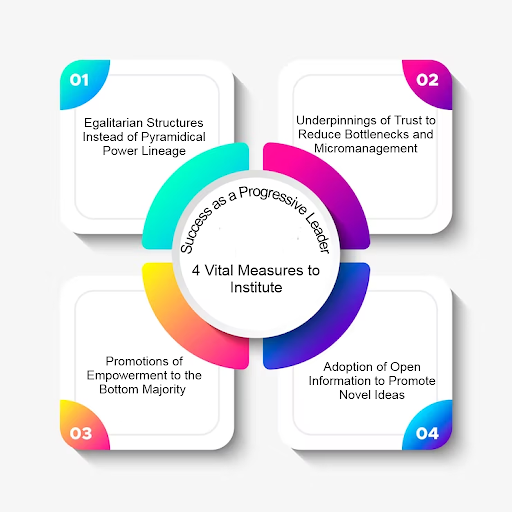For traditional leaders, the command-and-control leadership style has been the go-to, but it simply doesn’t work anymore. In a modern corporate arena, traditional leadership is outdated, mainly because it is governed by the principles that defined the Industrial Revolution.
Modern leadership has new standards to meet, which has always set progressives apart. With a focus on development and growth, their people are treated as a community and grow as one. To progressive leaders, people are the most important element, and coercion and dominance through a top-down leadership approach don’t come through.
Another essential quality of progressive leaders is that their people are a priority. An example of this was witnessed when Sanjiv Bajaj, Chairman and Managing Director, Bajaj Finserv Ltd., stated, “It is the employees who practise our cultural traits on an everyday basis. We remain committed to creating an environment that fosters our cultural traits and creates a dynamic workplace for our employees.”
It is clear that times have changed, and with it, our ideas about leadership, productivity, and progress have also evolved. In this new business paradigm, progressive leaders focus on real-world issues, where much of it has to do with improving the well-being of people and communities in a way that has a lasting impact.
Apart from Mr. Bajaj, the list of progressive leaders also includes Kumar Mangalam Birla, Nita Ambani, Sunil Bharti Mittal, and Azim Premji. So, how have the best business leaders adopted a progressive leadership style, and how can aspiring leaders emulate these titans? Read on to find out.
-
Egalitarian Structures Instead of Pyramidical Power Lineage
Success may lead leaders to fall into the trap of thinking that they know everything. After all, they have worked hard to be where they are and have experienced making tough decisions. However, progressive leaders concede that relying too heavily on one’s ability in decision-making can have steep repercussions.
Egalitarianism in corporate management sees collaborative ‘groupism rather than bossism, choicism, and chancism’ as the departure point for cooperative behaviour. Thus, progressive leadership models seek to abolish traditional class systems, favouring more egalitarian and non-hierarchical structures.
Abolishing power hierarchies by adopting the same behavioural rules, rewards systems, and operating processes for all, regardless of rank and position, allows organisations to be collaborative and, in turn, more productive.
A Stanford study also proves the same by pointing out that employees who worked in collaborative workspaces were 50% more effective in completing their tasks and were more engaged with their work.
-
Underpinnings of Trust to Reduce Bottlenecks and Micromanagement
In today’s network economy, many outward-thinking leaders are arguing to move a step ahead of collaboration to embrace a culture of co-creation as a key business enabler in organisations.
They believe collaboration was a trend, as almost 80% of the companies in North America, Asia-Pacific, and Europe put in place some kind of formal and informal collaborative practices.
While concepts of both collaboration and trust differ, they can coexist to enable co-creation, with the former developing a platform for building the latter. Simultaneously, trusting in people and practices allows top management and employees to co-create and deliver desired results.
Common practices that evolve through trust and that help build further trust in the workplace include:
-
Allowing filtration of decision-making power to the bottom majority
-
Creating space and environment for new ranks of leadership to emerge
-
Relying on the wisdom of the majority rather than a selected few
A recent BusinessWire survey of business executives and employees from 11 nations found that most of them (63%) believed that trust must be earned rather than presumed. In fact, this feeling is most prevalent in India, where 90% of them believe the same.
Nearly two-thirds of the respondents believed that trust in the workplace increased their sense of belongingness to work.
-
Promotions of Empowerment to the Bottom Majority
As opposed to traditional command-and-control organisations, progressive leadership sees knowledge as the key to empowering employees. While the imperative of learning lies in the employee, progressive leaders create a conducive environment. One where employees can access mentors to guide them toward the right learning path.
Leaders in such progressive organisations support their staff to challenge the status quo and bring in new and innovative solutions. Moreover, they assist their employees to thrive by linking authority to the ability to lead by example rather than hierarchical positions.
Active listening on the part of the leaders also makes employees feel a sense of empowerment in the workplace. In fact, employees who feel that they are being heard in their workplace are 4.6 times more likely to feel empowered.
-
Adoption of Open Information to Promote Novel Ideas
The information model in the traditional leadership style works only on a need-to-know basis. Thus, it is mostly restricted to the top of the pyramidical organisational structure. On the other hand, progressive leaders do not hesitate to share information with their employees in the name of sensitivity.
Such leaders also engage with their subordinates in hard discussions about cutbacks, reorganisations, and project details so their staff can stay informed about their work life.
For a long time, it has been recognised that the concentration of information provides a layer of protection to top management from the lower levels of the traditional pyramid. However, progressive leaders argue that this layer of protection is unnecessary because customer, financial, and work-process transparency is crucial for the well-being of large organisations.
The open model of information sharing also helps in ensuring the free flow of ideas from the bottom to the top. Thus, progressive leadership that great ideas that may have been stuck at the bottom get an opportunity to flourish.
Inherently, progressive leaders have a sense of confidence and strength in themselves, and these are core parts of a winning personality. As leaders, they can transform themselves into collaborators, teachers, and mentors. They function from the stance of wisdom, and not just their own, but the wise ones who surround them. The progressive leadership style values relationships and believes real power and energy flow through them to empower others.









